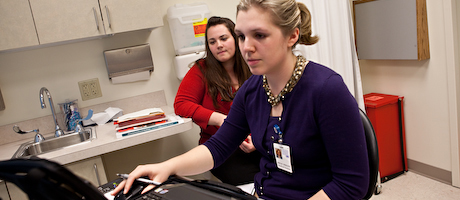By Jennifer Price
HIV. Diabetes. Hypertension.
These are just some of the conditions GW medical students are helping treat at a new student-run clinic in Southeast Washington’s Anacostia neighborhood.
In an effort to meet more of the need in the medically underserved community, GW’s Health, Education, Active Living (HEALing) Clinic expanded to include the Anacostia location last month.
“We wanted to give more students a chance to work in underserved areas, and we wanted to meet more of the patient need in the District,” said Rahul Vanjani, co-director of the HEALing Clinic and a second year medical student at GW. “And we cared more about moving to where the need was in the District as opposed to finding a site that’s near Foggy Bottom and convenient to our students. So that naturally led us to Anacostia.”
Historically one of the poorest parts of the District, Anacostia residents have little access to physician offices or hospitals. In fact, there’s only one hospital, United Medical Center, east of the Anacostia River, according to Lisa Alexander, associate dean for community based partnerships at GW’s School of Medicine and Health Sciences.
“Often these patients aren’t able or don’t feel comfortable going over to Northwest to see a doctor,” says Dr. Alexander, associate professor of Health Care Sciences. “They want to stay in their neighborhood to get their primary care.”
And because there’s little access to medical care in Anacostia, many residents have not managed their chronic conditions.
“Not only do some of them have HIV, they also have substance abuse problems and chronic diseases,” says Dr. Alexander, faculty adviser for the clinic. “Hypertension and diabetes are rampant in this population.”
Mr. Vanjani, who received his bachelor’s degree from GW in 2007, says He’s never seen patients like this before.
"We are in the most underserved community in D.C. Their health problems are so severe,” says Mr. Vanjani, who hopes to open his own free clinic one day. “It’s nice to know that I’m able to help and make a difference while still in medical school.”
The clinic, which is located at the Family and Medical Counseling Service in Anacostia, is open every Tuesday evening from 5 to 8 p.m., offering after-hours primary care to patients who cannot schedule an appointment during daytime hours. Thanks to a partnership with Family and Medical Counseling Services, a nonprofit organization that provides primary care services to vulnerable residents of Anacostia, GW students are able to use their exam rooms, laboratory and medical equipment.
“The patients we see here are really sick. They have numbers and vital signs you would never think they’d be able to walk around with,” says Megan Morales, a fourth year medical student.
In addition to examining and treating patients, the students work as lab technicians, patient educators, medical researchers and receptionists. An attending physician is on site to oversee patient care. While the majority of the students who volunteer are medical students, some are pursuing their master’s in public health or health administration or are enrolled in the physician assistant program.
Because there is such a demand to volunteer in the clinic, students enter into a lottery and about 100 are selected to work at the two different sites. About 15 students work per night. Fourth year medical students receive credit for working at the clinic and are responsible for teaching the first and second year students.
“It’s a unique opportunity to have this level of patient contact. You’re in your first or second year of medical school, and you’re paired with a fourth year student. And you get to do medicine,” says Marissa Watts, co-director of the HEALing Clinic and a second year medical student at GW.
Because they’ve just opened the clinic, the students only see about five patients per night, but that number will increase as time goes on. Providing comprehensive care is an essential part of the clinic so students spend about an hour with each patient and are responsible for following up with their patients after appointments to make sure they are taking their medications.
“Establishing a good rapport with the patients is very important because you already know the patient’s history, and the patient already trusts you,” says Ms. Morales, who plans to go into internal medicine.
In addition to running the clinic in Anacostia, GW students are continuing to operate a clinic out of Bread for the City, a nonprofit organization in Northwest Washington that provides comprehensive services, including food, clothing, medical care, legal and social services.
“It’s an important experience for students to see the underserved population,” Dr. Alexander says. “They need to see the disparities and how patients manage to get through a day when they hardly have money to take the bus to see a doctor.”
Comments? Criticism? The conversation continues. We welcome reactions, commentary and story recommendations on our Facebook page.


